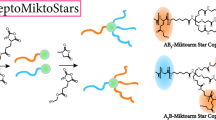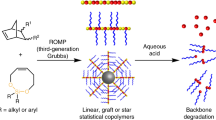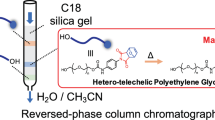Abstract
Poly(ethylene glycol) (PEG) is a biocompatible, flexible, and hydrophilic polymer that is widely applied in numerous fields. Especially in pharmaceutical research, PEG is used as a bioconjugate agent for PEG-ylated drugs. A well-defined structure is crucial, since dispersity affects biological activity (e.g., toxicity and efficacy). Thus, intensive efforts to develop synthetic protocols approaching uniformity have been made in recent decades. Different approaches utilizing iterative step-by-step synthesis procedures have yielded promising results, and improvement is still ongoing. In this comparative study, we adopted several procedures for the preparation of uniform PEGs in combination with careful characterization, including size exclusion chromatography (SEC) analysis, which has yet to be reported. Oligo(ethylene glycol)s up to the dodecamer were synthesized. The results obtained were compared in terms of yield and purity with those previously reported in the literature. We clearly show the importance of SEC analysis with high separation capacity in the oligomer range for the synthesis of short-chain oligo(ethylene glycol)s.
This is a preview of subscription content, access via your institution
Access options
Subscribe to this journal
Receive 12 print issues and online access
$259.00 per year
only $21.58 per issue
Buy this article
- Purchase on Springer Link
- Instant access to full article PDF
Prices may be subject to local taxes which are calculated during checkout
















Similar content being viewed by others
References
J Whelan, C Pan. (Bayer Pharmaceuticals Corporation, USA), PCT Application WO. 2005-US20469, 2005.
Brocchini S, Godwin A, Balan S, Choi J-W, Zloh M, Shaunak S. Disulfide bridge based PEGylation of proteins. Adv Drug Deliv Rev. 2008;60:3–12.
Haag R, Kratz F. Polymer therapeutics: concepts and applications. Angew Chem Int Ed Engl. 2006;118:1218–37.
Zalipsky S. Chemistry of polyethylene glycol conjugates with biologically active molecules. Adv Drug Deliv Rev. 1995;16:157–82.
Greenwald RB, Choe YH, McGuire J, Conover CD. Effective drug delivery by PEGylated drug conjugates. Adv Drug Deliv Rev. 2003;55:217–50.
Roberts MJ, Bentley MD, Harris JM. Chemistry for peptide and protein PEGylation. Adv Drug Deliv Rev. 2012;64:116–27.
Caliceti P, Veronese FM. Pharmacokinetic and biodistribution properties of poly(ethylene glycol)–protein conjugates. Adv Drug Deliv Rev. 2003;55:1261–77.
Harris JM, Chess RB. Effect of pegylation on pharmaceuticals. Nat Rev Drug Discov. 2003;2:214–21.
Veronese FM, Pasut G. PEGylation, successful approach to drug delivery. Drug Discov Today. 2005;10:1451–8.
Fishburn CS. The Pharmacology of PEGylation: Balancing PD with PK to generate novel therapeutics. J Pharm Sci. 2008;97:4167–83.
Knop K, Hoogenboom R, Fischer D, Schubert US. Poly(ethylene glycol) in drug delivery: pros and cons as well as potential alternatives. Angew Chem Int Ed. 2010;49:6288–308.
Furusho H, Kitano K, Hamaguchi S, Nagasaki Y. Preparation of stable water-dispersible PEGylated gold nanoparticles assisted by nonequilibrium atmospheric-pressure plasma jets. Chem Mater. 2009;21:3526–35.
Ganapatibhotla LVNR, Zheng J, Roy D, Krishnan S. PEGylated imidazolium ionic liquid electrolytes: thermophysical and electrochemical properties. Chem Mater. 2010;22:6347–60.
Shah SAS, Nag M, Kalagara T, Singh S, Manorama SV. Silver on PEG-PU-TiO2 polymer nanocomposite films: An excellent system for antibacterial applications. Chem Mater. 2008;20:2455–60.
Elimelech H, Avnir D. Sodium-Silicate Route to Submicrometer Hybrid PEG@Silica Particles. Chem Mater. 2008;20:2224–7.
Sigma-Aldrich prices 2019. https://www.sigmaaldrich.com. Accessed 08. Oct 2019.
Perry SZ, Hibbert H. Studies on reactions relating to carbohydrates and polysaccharides: XLVIII. Ethylene Oxide and related compounds: Synthesis of the Polyethylene Glycols. Can J Res. 1936;14B:77–83.
Keegstra EMD, Zwikker JW, Roest MR, Jenneskens LW. A highly selective synthesis of monodisperse oligo(ethylene glycols). J Org Chem. 1992;57:6678–80.
Harada A, Li J, Kamachi M. Preparation and characterization of a polyrotaxane consisting of monodisperse Poly(ethylene glycol) and α-Cyclodextrins. J Am Chem Soc. 1994;116:3192–6.
Burns CJ, Field LD, Hashimoto K, Petteys BJ, Ridley DD, Sandanayake KRAS. A convenient synthetic route to differentially functionalized long chain polyethylene glycols. Synth Commun. 1999;29:2337–47.
Loiseau FA, Hii KK, Hill AM. Multigram synthesis of well-defined extended bifunctional polyethylene glycol (PEG) Chains. J Org Chem. 2004;69:639–47.
Ahmed SA, Tanaka M. Synthesis of oligo(ethylene glycol) toward 44-mer. J Org Chem. 2006;71:9884–6.
Niculescu-Duvaz D, Getaz J, Springer CJ. Long functionalized poly(ethylene glycol)s of defined molecular weight: synthesis and application in solid-phase synthesis of conjugates. Bioconj Chem. 2008;19:973–81.
French AC, Thompson AL, Davis BG. High purity discrete PEG oligomer crystals allow structural insight. Angew Chem Int Ed. 2009;48:1248–52.
Székely G, Schaepertoens M, Gaffney RRJ, Livingston AG. Iterative synthesis of monodisperse PEG homostars and linear heterobifunctional PEG. Polym Chem. 2014;5:694–7.
Li Y, Guo Q, Li X-F, Zhang H, Yu F-H, Yu W-J, Xia G-Q, Fu M-Y, Yang Z-G, Jiang Z-X. Fluorous synthesis of mono-dispersed poly(ethylene glycols). Tetrahedron Lett. 2014;55:2110–3.
Maranski K, Andreev YG, Bruce PG. Synthesis of Poly(ethylene oxide) approaching monodispersity. Angew Chem Int Ed. 2014;53:6411–3.
Zhang Q, Ren H, Baker GL. A practical and scalable process to selectively monofunctionalized water-soluble α,ω-diols. Tetrahedron Lett. 2014;55:3384–6.
Zhang H, Li X, Shi Q, Li Y, Xia G, Chen L, Yang Z, Jiang Z-X. Highly efficient synthesis of monodisperse Poly(ethylene glycols) and derivatives through macrocyclization of oligo(ethylene glycols). Angew Chem Int Ed. 2015;54:3763–7.
Wawro AM, Muraoka T, Kato M, Kinbara K. Multigram chromatography-free synthesis of octa(ethylene glycol) p-toluenesulfonate. Org Chem Front. 2016;3:1524–34.
Khanal A, Fang S. Solid phase stepwise synthesis of polyethylene glycols. Chem Eur J. 2017;23:15133–42.
Fordyce R, Lovell EL, Hibbert H. Studies on reactions relating to carbohydrates and polysaccharides. LVI. The synthesis of the higher polyoxyethylene glycols. J Am Chem Soc. 1939;61:1905–10.
Székely G, Schaepertoens M, Gaffney PRJ, Livingston AG. Beyond PEG2000: Synthesis and functionalisation of monodisperse PEGylated homostars and clickable bivalent polyethyleneglycols. Chem Eur J. 2014;20:10038–51.
Williamson A. Theory of aetherification. Philos Mag. 1850;37:350–6.
Boden N, Bushby RJ, Clarkson S, Evans SD, Knowles PF, Marsh A. The design and synthesis of simple molecular tethers for binding biomembranes to a gold surface. Tetrahedron. 1997;53:10939–52.
Reed NN, Janda KD. A one-step synthesis of monoprotected polyethylene glycol ethers. J Org Chem. 2000;65:5843–5.
Zhang J, Zhao Y-J, Su Z-G, Ma G-H. Synthesis of monomethoxy poly(ethylene glycol) without diol poly(ethylene glycol). J Appl Polym Sci. 2007;105:3782–6.
Bouzide A, Sauvé G. Silver(I) oxide mediated highly selective monotosylation of symmetrical diols. application to the synthesis of polysubstituted cyclic ethers. Org Lett. 2002;4:2329–32.
Coudert G, Mpassi M, Guillaumet G, Selve C. A Novel, Unequivocal synthesis of polyethylene glycols. Synth Commun. 1986;16:19–26.
Wawro AM, Muraoka T, Kinbara K. Chromatography-free synthesis of monodisperse oligo(ethylene glycol) mono-p-toluenesulfonates and quantitative analysis of oligomer purity. Polym Chem. 2016;7:2389–94.
Wan Z, Li Y, Bo S, Gao M, Wang X, Zeng K, Tao X, Li X, Yang Z, Jiang Z-X. Amide bond-containing monodisperse polyethylene glycols beyond 10 000 Da. Org Biomol Chem. 2016;14:7912–9.
Xia G, Li Y, Yang Z, Jiang Z-X. Development of a scalable process for α-Amino-ω-methoxyl-dodecaethylene glycol. Org Process Res Dev. 2015;19:1769–73.
Li Y, Thapa B, Zhang H, Li X, Yu F, Jeong E-K, Yang Z, Jiang Z-X. Synthesis of gemini surfactants with twelve symmetric fluorine atoms and one singlet 19F MR signal as novel 19F MRI agents. Tetrahedron. 2013;69:9586–90.
Acknowledgements
This work was supported by the DFG within the framework of the collaborative research centre 1176 (SFB 1176, project C3). The authors would like to acknowledge Peter Gödtel, Maximilian Knab, Rebecca Seim, and Fabienne Urbanek for synthetic support; the analytical team from KIT for analytical support; and Prof. Barner-Kowollik and his group for access to SEC-ESI-MS equipment.
Author information
Authors and Affiliations
Corresponding author
Ethics declarations
Conflict of interest
The authors declare no conflict of interest.
Additional information
Publisher’s note Springer Nature remains neutral with regard to jurisdictional claims in published maps and institutional affiliations.
Supplementary information
Rights and permissions
About this article
Cite this article
Bohn, P., Meier, M.A.R. Uniform poly(ethylene glycol): a comparative study. Polym J 52, 165–178 (2020). https://doi.org/10.1038/s41428-019-0277-1
Received:
Revised:
Accepted:
Published:
Issue Date:
DOI: https://doi.org/10.1038/s41428-019-0277-1
This article is cited by
-
Effects of the Addition of Poly(ethylene Glycol) and Non-ionic Surfactants on Pretreatment, Enzymatic Hydrolysis, and Ethanol Fermentation
BioEnergy Research (2022)
-
Reading mixtures of uniform sequence-defined macromolecules to increase data storage capacity
Communications Chemistry (2020)



